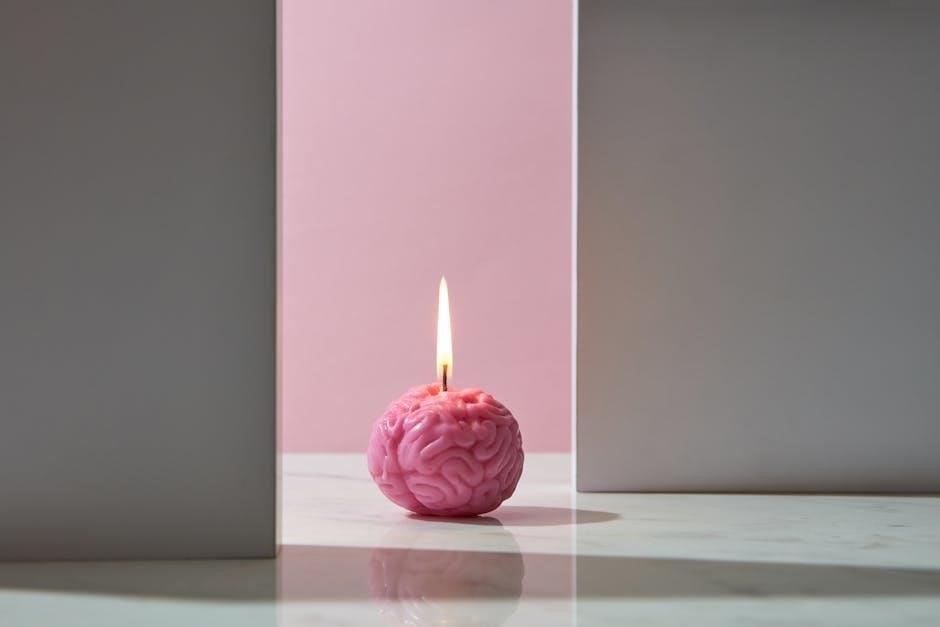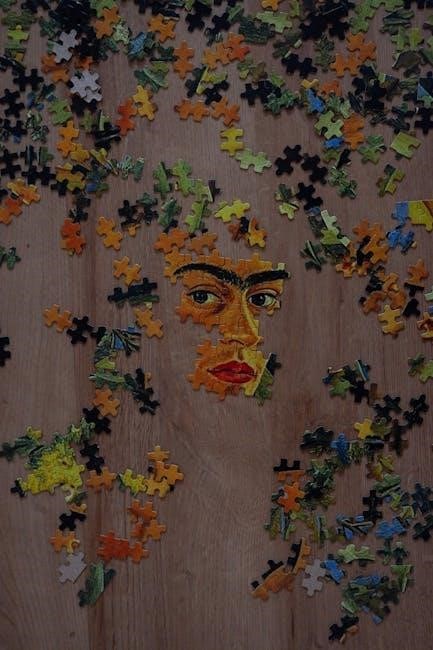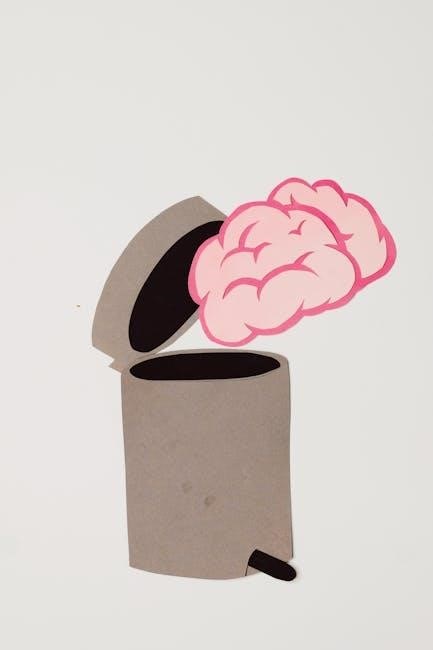Neuroaesthetics explores the brain’s response to art, merging psychology, biology, and evolution. It reveals how creative experiences transform brain function, as highlighted in Your Brain on Art.
1.1 Defining Neuroaesthetics and Its Role in Understanding Art’s Impact on the Brain
Neuroaesthetics is the scientific study of how art influences the brain, blending psychology, biology, and evolution. It aims to understand the neural mechanisms behind aesthetic experiences, revealing how art shapes emotions, cognition, and behavior. This interdisciplinary field provides insights into the transformative power of art on mental well-being and creativity, as explored in Your Brain on Art.
1.2 The Evolution of Art and Brain Science
The evolution of art and brain science reveals how creative expression has shaped human cognition. Early humans used art for communication and emotional expression, fostering brain development. Modern neuroscience, as explored in Your Brain on Art, shows how art activates brain regions linked to creativity, emotion, and memory. This interdisciplinary field bridges aesthetics and biology, illuminating art’s role in human evolution and brain function.

How Art Affects Brain Function
Art profoundly impacts brain function by enhancing creativity, emotion, and memory. It reduces stress, boosts focus, and activates regions linked to pleasure and mental well-being.
2.1 The Brain’s Response to Visual and Performing Arts
Engaging with visual and performing arts activates the brain’s reward circuitry, reducing stress and enhancing focus. Activities like dancing, painting, and music stimulate the prefrontal cortex, boosting creativity and emotional processing. These aesthetic experiences not only alter brain function but also foster long-term neurological benefits, as highlighted in Your Brain on Art.
2.2 The Role of the Prefrontal Cortex in Creative Engagement
The prefrontal cortex plays a crucial role in creative engagement, enabling focus, decision-making, and emotional regulation. Activities like art and music activate this region, fostering innovation and problem-solving. As noted in Your Brain on Art, doodling and creative tasks stimulate the prefrontal cortex, enhancing cognitive function and mental clarity, while reducing stress and improving overall brain health.
The Mental Health Benefits of Art
Engaging in art reduces stress and anxiety, enhancing mental well-being. Activities like painting and dancing lower mental distress, boosting life satisfaction and cognitive functioning, as shown in Your Brain on Art.
3.1 Art as a Tool for Reducing Stress and Anxiety
Engaging in artistic activities like painting, dancing, or expressive writing transforms stress and anxiety into calmness. These practices activate the brain’s reward system, reducing cortisol levels and releasing endorphins. Art provides a healthy distraction, fostering mindfulness and emotional balance. As highlighted in Your Brain on Art, creative expression becomes a therapeutic outlet, enhancing mental resilience and overall well-being.
3.2 The Connection Between Art and Mental Well-Being
Engaging with art activates the brain’s reward circuitry, releasing dopamine and fostering feelings of pleasure and satisfaction. Creative activities like painting and dancing enhance self-esteem and provide a sense of accomplishment. This mental upliftment strengthens emotional resilience and overall well-being. As explored in Your Brain on Art, art’s impact extends beyond individual benefits, fostering connections and building stronger, healthier communities.

The Power of Creative Activities
Creative activities like painting, dancing, and writing profoundly impact brain function, enhancing mental health and well-being. These practices foster focus, reduce stress, and boost life satisfaction, as detailed in Your Brain on Art.
4.1 The Impact of Painting, Dancing, and Writing on the Brain
Painting, dancing, and writing are powerful creative activities that significantly influence brain function. Painting enhances focus and fine motor skills, while dancing reduces stress and boosts emotional well-being. Writing stimulates the prefrontal cortex, improving cognitive clarity and emotional processing. These activities, as explored in Your Brain on Art, foster mental resilience, creativity, and overall brain health, demonstrating art’s transformative power on both mind and body.
4.2 How Doodling and Focus Relate to Brain Activity
Doodling activates the prefrontal cortex, enhancing focus and improving information retention. It reduces mind-wandering, fostering cognitive clarity and engagement. As explored in Your Brain on Art, such creative expressions strengthen neural pathways, linking art and brain function in ways that boost productivity and mental well-being, highlighting the profound impact of simple, everyday creative acts on brain activity.
Art and Community Building
Art fosters social connections, strengthening communities through shared creative experiences. Activities like gardening and music, as highlighted in Your Brain on Art, unite people, promoting collective well-being and cultural growth.
5.1 The Role of Art in Strengthening Social Connections
Art serves as a powerful catalyst for social bonding, fostering shared experiences and empathy. Engaging in creative activities like painting or music strengthens interpersonal connections, reducing stress and anxiety while enhancing collective well-being. As highlighted in Your Brain on Art, these shared practices create a sense of belonging, fostering resilient and inclusive communities.
5.2 Gardening and Music as Forces for Community Engagement
Gardening and music are potent tools for fostering community engagement. Both activities create shared spaces for collaboration and expression, strengthening social bonds. Gardening fosters teamwork and pride in collective growth, while music unites people through rhythm and emotion. These practices, as discussed in Your Brain on Art, enhance mental well-being and cultivate a sense of unity, transforming individuals and communities alike.
The Science Behind Art’s Transformative Power
Neuroaesthetics reveals how art reshapes brain structure and function, enhancing creativity and emotional resilience. Your Brain on Art highlights this science, proving art’s profound impact on human evolution and culture.
6.1 How Aesthetic Experiences Shape Brain Structure and Function
Aesthetic experiences, such as viewing art or engaging in creative activities, reshape brain structure and function. They activate the brain’s reward circuitry, releasing dopamine and fostering emotional connections. Neuroplasticity is enhanced, strengthening neural pathways linked to creativity, focus, and emotional resilience. This transformation is evident in increased activity in the prefrontal cortex and default mode network, fostering introspection and cognitive growth, as detailed in Your Brain on Art.
6.2 The Intersection of Art, Neuroscience, and Human Evolution
Art and neuroscience reveal how creativity has shaped human evolution. Activities like painting and dancing reflect cognitive advancements, fostering emotional expression and social bonding. Engaging with art stimulates dopamine release, reinforcing neural pathways linked to creativity and empathy. This intersection highlights how art has driven human progress, as explored in Your Brain on Art, connecting past and present in the quest to understand our evolving brains.

Art and Education
Art and education are deeply connected, transforming the brain through creative engagement, enhancing academic and social skills while fostering cognitive growth, as highlighted in ‘Your Brain on Art.’
7.1 The Impact of Arts Education on Academic and Social Skills
Arts education profoundly transforms the brain, enhancing academic and social skills. Engaging in creative activities like painting, dancing, and writing fosters cognitive growth, creativity, and empathy. Studies show that arts education improves problem-solving abilities, memory, and collaboration, while reducing stress and anxiety; These benefits contribute to overall brain development and lifelong learning, as detailed in Your Brain on Art.
7.2 How Art Enhances Learning and Cognitive Development
Engaging in art enhances learning by activating brain regions linked to creativity, memory, and focus. Activities like expressive writing, music, and visual arts stimulate neural pathways, improving cognitive flexibility and critical thinking. This neurological engagement fosters deeper understanding and retention of information, making art a powerful tool for enriched learning experiences, as explored in Your Brain on Art.

The Cultural and Social Impact of Art
Art mirrors human culture and identity, fostering social connections and unity. It transforms lives, as highlighted in Your Brain on Art, enhancing collective well-being and cultural understanding.
8.1 Art as a Reflection of Human Culture and Identity
Art serves as a mirror of human culture and identity, capturing societal values, traditions, and emotions. It preserves collective memories and fosters empathy, connecting individuals across generations. Through various forms like music, dance, and visual arts, it reflects the diversity of human experiences. As discussed in Your Brain on Art, art’s cultural resonance strengthens social bonds and enriches our shared humanity, promoting mental well-being and societal growth.
8.2 The Role of Art in Building Healthier Communities
Art fosters community engagement and social cohesion, essential for healthier communities. Initiatives like public art installations and collaborative projects encourage cooperation and shared identity. As highlighted in Your Brain on Art, community-focused creative activities enhance mental well-being, reduce social isolation, and strengthen collective resilience, ultimately contributing to the development of thriving, inclusive societies where individuals can flourish together.
The Future of Art and Brain Science
Emerging research in neuroaesthetics, as explored in Your Brain on Art, highlights the potential of art to advance medicine and enhance well-being, shaping a transformative future.
9.1 Emerging Research in Neuroaesthetics
Emerging research in neuroaesthetics, as detailed in Your Brain on Art, reveals how aesthetic experiences reshape brain structure and function. Advanced imaging techniques are uncovering how art impacts neural pathways, offering insights into creativity, perception, and emotional processing; This interdisciplinary field is transforming our understanding of how art influences human cognition and behavior, paving the way for innovative applications in health and education.
9.2 The Potential of Art in Advancing Medicine and Well-Being
Art is emerging as a powerful tool in medicine, enhancing recovery and well-being. Research highlights how creative activities like painting, music, and writing reduce stress, improve mental health, and foster resilience. By integrating art into therapy, healthcare systems can address emotional and cognitive challenges more effectively, promoting holistic healing and improving quality of life for individuals and communities alike.
Art profoundly impacts brain function, fostering mental well-being, creativity, and social connections. Embracing art enriches lives, driving personal and societal growth through its transformative power.
10.1 Summarizing the Transformative Power of Art on the Brain
Art profoundly reshapes brain structure and function, enhancing creativity, emotional regulation, and cognitive health. Activities like painting, dancing, and music reduce stress, boost mental clarity, and foster social bonds. As highlighted in Your Brain on Art, these experiences create lasting neurological changes, proving art’s vital role in personal and communal well-being, as shown by its impact on mental health and societal connections.
10.2 The Importance of Embracing Art for Personal and Societal Growth
Embracing art fosters personal growth by enhancing creativity, emotional resilience, and mental well-being. Societally, art bridges cultural divides, promotes empathy, and strengthens community bonds. As highlighted in Your Brain on Art, engaging with art cultivates a healthier, more compassionate society, underscoring its vital role in human evolution and collective flourishing.